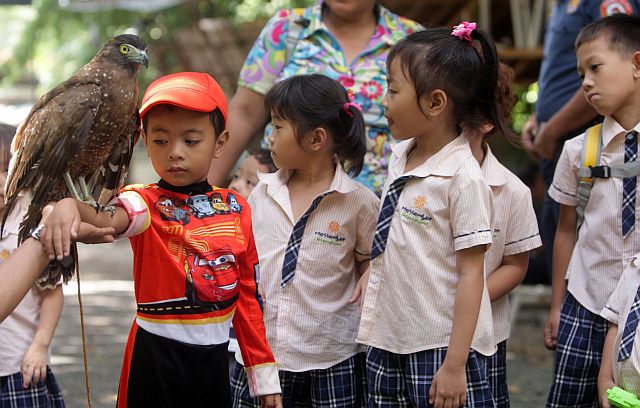
School children
experience getting close to live animals at the Cebu Zoo. (CDN PHOTO/TONEE DESPOJO)
For the past nine years, “Roger” spent his days with the different animals inside the Cebu Wildlife Resources Conservation and Protection Office (CWRCPO) in Cebu City.
The bond he has made with the animals including different types of birds, crocodiles and even snakes was more than just that of a caretaker and animals, said the man who asked that his real name be withheld.
This is why despite losing his job as a casual employee assigned at the CWRCPO, which used to be called as the Cebu Zoo, he continues to visit and do volunteer work in the facility.
“I’ve been here since 2007. I’m a trained wildlife officer. Dili ko dali-dali makabiya sa mga animals diri. Pila sad baya mi ka tuig nagkuyog. Mingawon sad ko. Ako gyud magpakaon nila. Mao na nga hangtud karon, moboluntaryo gihapon ko og anhi (I can’t just easily leave behind the animals. I’ve spent several years with them, I also miss them. I am the one who feeds them. That’s why until now, I still volunteer here),” he told Cebu Daily News, which visited the facility yesterday.
Roger lives just a few meters from the zoo, which is located in Barangay Kalunasan.
And with no other job for now, Roger is making some money by being a part-time habal-habal (motorcycle-for-hire) driver.
He is among the 25 casual employees of the CWRCPO whose appointments were not renewed by Cebu City Mayor Tomas Osmeña last July.
Wrong fit
Aside from firing all the zoo’s personnel, Osmeña also assigned three city officials in the zoo who admittedly have no related experience in working with wildlife.
Former Cebu City Veterinarian and head of the Department of Veterinary Medicine and Fisheries (DVMF) Dr. Pilar Romero was appointed by the mayor as officer-in-charge of the CWRCPO. Lucia Mahusay, who used to be the assistant department head of the Department of Social Welfare and Services (DSWS), was also appointed as Romero’s assistant.
Although a veterinarian, Romero admitted that her previous job is entirely different from maintaining a wildlife center even if the love and compassion for animals remain in her blood.
“Naglisod gyud mi. Dili mi kahibaw intawon moduol anang mga buwaya. Mao nang nihangyo gyud mi sa mga caretaker sa una nga motabang namo,” Romero told CDN.
(It’s really difficult for us. We don’t know how to get near the crocodiles. That’s why we requested the former caretakers to help us out.)
One of the monkeys at the Cebu City zoo. (CDN PHOTO/TONEE DESPOJO)
Pythons gone
Although the wildlife center is seven hectares big, only around one hectare is occupied and being used.
Among the mandates of the CWRCPO is to provide attraction and education facilities that will showcase the conservation and protection of wildlife resources and to make people aware of animal existence and habitat.
The facility charges P25 for every adult and P10 for children as entrance fees.
When CDN visited yesterday, a group of Filipino-Korean toddlers were enjoying the presence of the animals.
A brave young boy even tried having a Rufous Night Heron stand on his arm, much to the enjoyment of his friends.
But the famous snake massage in the facility was stopped this week. The former head of the facility, Fr. Giovanni Romarate, decided to take the three pythons with him since he was no longer working for the facility and it would be dangerous to leave behind the pythons without him to look after them.
Romarate, however, still regularly visits the facility to check on the animals.
Based on their latest inventory, the facility has 117 different kinds of birds, chicken and turkey; one Philippine brown deer; four civet cats; 14 saltwater crocodiles; five alligators; 30 turtles; five hammerhead sharks; six pythons, six goats, a sheep, 34 rabbits, a monitor lizard, some monkeys and several ornamental fishes.
Osmeña has not been sugarcoating his pronouncements that he apparently has no specific plans on what to do with the facility or the close to 300 wildlife inside it. (To be concluded)